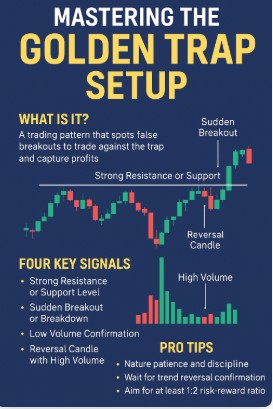In the high-stakes world of trading, understanding how markets behave—and how they often deceive—is the edge every trader needs. One of the most underrated yet powerful patterns in the market is known as the Golden Trap Setup. This strategy helps identify false breakouts, protects traders from emotional mistakes, and offers precise opportunities for profitable entries.
Let’s dive deep into this unique and effective trading strategy.

📌 What is the Golden Trap Setup?
The Golden Trap Setup is a trading strategy designed to spot false breakouts—a common market phenomenon where the price appears to break through a significant level, only to reverse direction quickly.
This trap catches many retail traders on the wrong side of the trade. But with the right knowledge, you can use it to your advantage by trading against the trap.
🧠 Why It Works
Markets are driven by human psychology—fear, greed, and urgency. Trap setups occur when:
- Retail traders chase a breakout, assuming the price will continue moving in that direction.
- Big players (institutions) use this opportunity to create liquidity by placing large reverse trades.
- The price reverses suddenly, trapping the initial breakout traders and rewarding those who recognized the setup.
🧩 Components of the Golden Trap Setup
To effectively trade the Golden Trap Setup, look for these four key signals:
- Strong Resistance or Support Zone
- Clearly defined on a higher time frame (15-min or 1-hour).
- The level has been tested multiple times.
- Sudden Breakout or Breakdown
- A price spike just above resistance or below support.
- Creates the illusion of a breakout.
- Low Volume on the Breakout
- Lack of institutional support.
- Indicates a weak and unreliable breakout.
- Reversal Candle with High Volume
- A strong engulfing or pin-bar candle.
- Must show decisive reversal backed by volume.
🎯 How to Trade the Trap
Once you spot the above signals, here’s how to enter and manage the trade:
- Entry: Enter the trade against the breakout direction—after the reversal candle confirms.
- Stop Loss: Place a tight stop loss just beyond the fake breakout wick.
- Target: Aim for at least 1:2 or 1:3 risk-to-reward based on price structure.
📊 Real Market Example (Hypothetical)
Let’s say Nifty is hovering around a resistance zone at 22,200. Suddenly, a green candle breaks above to 22,260—but volume is unusually low. Shortly after, a large red candle forms and closes below 22,200 with high volume.
This is a classic Golden Trap Setup:
✅ Short Entry: Around 22,180
📉 Stop Loss: 22,270
📈 Target: 22,000 or below
Result? A quick and clean move as the trapped longs rush to exit.
🧘 Psychology and Discipline
The biggest challenge in trap trading is patience and discipline. Many traders enter breakouts emotionally, hoping for momentum. But the trap trader waits for confirmation and moves in the opposite direction.
Key Psychological Rules:
- Never chase price.
- Wait for confirmation.
- Don’t act on fear or FOMO.
- Always define your risk.
✅ Golden Trap Setup Checklist
| Element | Confirmation Required |
|---|---|
| Strong Support/Resistance | 2–3 touches on higher TF |
| Breakout/Breakdown Candle | Large, impulsive move |
| Volume on Breakout | Below average |
| Reversal Candle | High volume, clear structure |
| Risk-Reward Ratio | Minimum 1:2 |
📓 Pro Tips for Trap Traders
- Use 15-min to 1-hour charts for clearer trap zones.
- Combine with price action and volume profile for added accuracy.
- Backtest the setup over multiple trades before live trading.
- Always use position sizing and trading journal for review.
⚠️ Final Thoughts
The Golden Trap Setup is not a magic trick—but a strategic approach based on observing market manipulation. With practice, it can become one of the most reliable tools in your trading arsenal. Like all strategies, it works best when paired with discipline, consistency, and sound risk management.
📢 Disclaimer
Investing and trading in the stock market involves risk. The content provided above is for educational and informational purposes only and does not constitute financial advice or a recommendation to buy or sell any financial instrument. Always consult a SEBI-registered financial advisor before making investment decisions. Past performance does not guarantee future results.